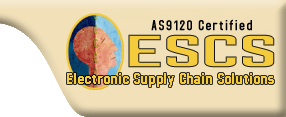 The following "Ten Steps" provide a checklist for what manufacturers should be doing to reduce
the risks associated with counterfeit electronic components. The greatest risk is complacency! You may
have distributors you have relied on for years; but with the increasing prevalence of counterfeit components, past
performance is unfortunately not always a good indicator of future results.
The following "Ten Steps" provide a checklist for what manufacturers should be doing to reduce
the risks associated with counterfeit electronic components. The greatest risk is complacency! You may
have distributors you have relied on for years; but with the increasing prevalence of counterfeit components, past
performance is unfortunately not always a good indicator of future results.
Risk in sourcing from franchised distributors is reduced, but may still exists where surplus returns have been co-mingled with
new inventory. Apply the following steps to all component procurement.
Consider each of the below steps in relation to your company's operating procedures. Is there a need for change?
|
|
10 Steps to Mitigate Counterfeit Risk
|
1. Set minimum standards for your distributors.
See our "Distributor Qualifications" for a list of criteria
ESCS believes manufacturers should require their distributors to meet.
2. Set an approval process for new distributors that actively confirms they
meet your minimum requirements. Make a site visit, and annually check that required
quality certifications are current. Reserve the right to perform surprise site inspections, with
minimal notice.
3. Track your distributors' actual quality and delivery performance. Establish
performance standards and communicate them to your distributors. Issue periodic reports on their achievement.
4. Beware of quotes that are substantially below expected market pricing. If the price is too good to be true,
it probably is.
5. Set purchase order conditions requiring original manufacturer's Certificates
of Compliance along with distributor's declaration that the product was sourced directly from either the original
component manufacturer or an authorized distributor. If either of these cannot be provided, specify what
authenticity and or functionality testing you require to be performed in advance by a third party test facility.
6. On receipt of components, examine packaging for proper company and product
information, and for proper electro-static protection. Examine paperwork to confirm actual lot and date codes
are consistent with documentation for the product delivered. Was the manufacturer QPL'd to make the device
for the date code presented? (See how to check a QPL in 30 seconds with ESCS's "QPL Drill-down".)
7. Establish in-coming inspection standards appropriate for the component's
intended application. High reliability parts for aerospace or military applications may require full
functionality tests, which may be satisfied by 3rd party testing in advance. A visual
inspection in accordance with a specified standard should be required on all deliveries.
8. Maintain membership in GIDEP and ERAI for information on parts that have been
counterfeited. Notify both of any counterfeit parts received.
9. Flow all of the above requirements down to any contract manufacturers.
10. Lastly, remember: "If it quacks like a duck, it probably is a duck."
Remain vigilant!
|
|
|
ESCS Industry Assessment
|
In October, 2008, ESCS completed a broad-based survey of over 90 quality and procurement professionals in the
aerospace and military manufacturing industryto gain an understanding of what steps they are taking to combat
counterfeits. Some companies are simply reducing total suppliers, while others have adopted new policies
providing for centralized vendor quality assessment and approval. Still, the diversity of responses is
quite revealing as to the state of the industry's development of best practices.
Find out what other companies are doing today to combat counterfeits.
View or download a copy here.
|
|



